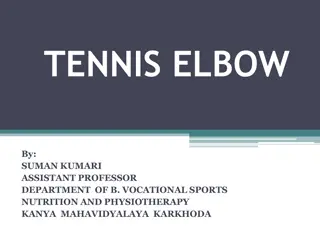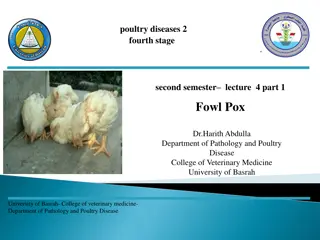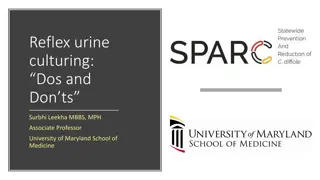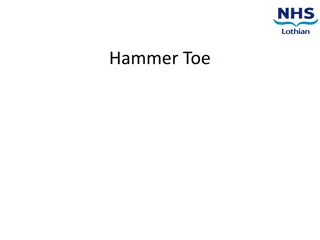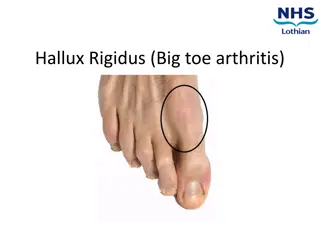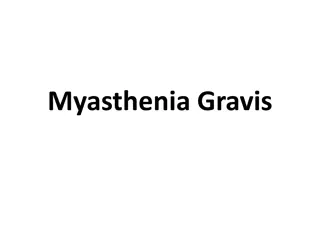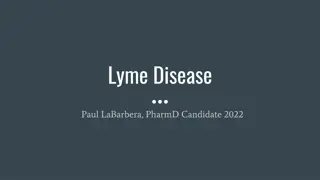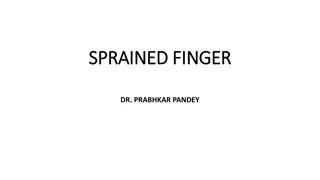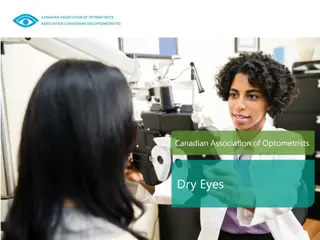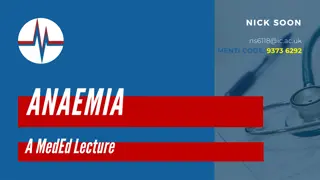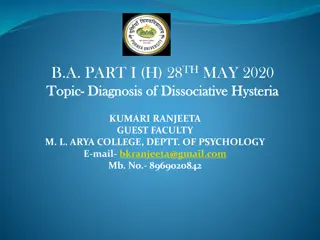Understanding Choledocholithiasis: Causes, Symptoms, and Diagnosis
Choledocholithiasis, the presence of stones in the common bile duct, is a common condition found in a percentage of patients with gallstones. The stones can be primary or secondary, causing a range of clinical manifestations from silent obstruction to cholangitis or gallstone pancreatitis. Diagnosis often involves routine blood tests and liver function tests, with bilirubin levels being a significant predictor for CBD stones. Symptoms may include pain, jaundice, and tenderness in the abdomen. Recognizing the signs and symptoms of choledocholithiasis is crucial for prompt management and treatment.
Download Presentation

Please find below an Image/Link to download the presentation.
The content on the website is provided AS IS for your information and personal use only. It may not be sold, licensed, or shared on other websites without obtaining consent from the author. Download presentation by click this link. If you encounter any issues during the download, it is possible that the publisher has removed the file from their server.
E N D
Presentation Transcript
CHOLEDOCHOLITHIASIS Common bile duct stones Small or large single or multiple Found in 6% to 12% of patients with stones in the GB The incidence increases with age. 2
CHOLEDOCHOLITHIASIS Primary CBD Stones that form in the bile ducts. Usually brown pigment type associated with biliary stasis &infection more commonly seen in Asian populations. The causes of biliary stasis that lead to the development of primary stones include biliary stricture, papillary stenosis, tumors, or other (secondary stones). Secondary CBD stones: formed within the gallbladder migrate down the cystic duct to the common bile duct. usually cholesterol stones 3
CHOLEDOCHOLITHIASIS CLINICAL MANIFESTATIONS SILENT ,often discovered incidentally. may cause obstruction, complete or incomplete,OR may manifest with cholangitis or gallstone pancreatitis. The PAIN of CBD Stone, also biliary colic (similar to cystic duct stone)=>Jaundice , Nausea and vomiting are common. 4
CHOLEDOCHOLITHIASIS PHYSICAL EXAMINATION may be normal, but mild epigastric or RUQ tenderness as well as mild icterus are common. The symptoms intermittent; pain and transient jaundice (temporarily impacts the ampulla but subsequently moves away, acting as a ball valve ) CBD stone resolution pass through the ampulla spontaneously become completely impacted severe progressive jaundice. 5
DIAGNOSTICSTUDIES ROUTINE Blood Tests : 1- CBC Increased WBC : raise suspicion of CHOLECYSTITIS. 2- LIVER FUNCTION TEST elevation of bilirubin, alkaline phosphatase, and aminotransferase, CHOLANGITIS should be suspected. elevation of conjugated bilirubin and a rise in alkaline phosphatase CHOLESTASIS. Serum aminotransferases may be normal or mildly elevated. In patients with biliary colic or chronic cholecystitis blood tests will typically be normal. 6
INITIALINVESTIGATIONS Liver Function Test (LFT) Completely normal: NPV > 97% Abnormal: PPV 15% Bilirubin is the strongest predictor for CBD stones ;specificity varies according to level Bilirubin 30 mol/L: specificity 60% Bilirubin 68 mol/L: specificity 75% Mean bilirubin in CBD stones: 25.5 32.3 mol/L 7
DIAGNOSTICSTUDIES 1-ULTRASONOGRAPHY Advantages: Initial investigation of GBD Noninvasive, painless, No radiation exposure can be performed on critically ill patients. Adjacent organs can frequently be examined at the same time. Disadvantages Operator dependent Not satisfactory for Obese patients, patients with ascites & distended bowel 8
DIAGNOSTICSTUDIES ULTRASONOGRAPHY GALLSTONE sensitivity and specificity >90%) dense, acoustic shadow Move with changes in position POLYPS may be calcified reflect shadows do not move with change in posture. Acoustic shadows from gall stones. 9
DIAGNOSISSTUDIES 2- Magnetic resonance cholangiography (MRC) provides excellent anatomic detail sensitivity and specificity of 95% and 89% detecting choledocholithiasis >5 mm in diameter 3- Endoscopic cholangiography (ERC) GOLD STANDARD FOR DIAGNOSING COMMON BILE DUCT STONES. distinct advantage : THERAPEUTIC OPTION at the time of diagnosis. 10
DIAGNOSTICSTUDIES 4- ORAL CHOLECYSTOGRAPHY OLD DAYS : diagnostic procedure of choice for gallstones, Replaced by ultrasonography. STONE FILLING DEFECTS oral administration of a radiopaquecompound absorbed, excreted by the liver, and passed into theGB. Stones are noted on a film as FILLING DEFECTS in a visualized, opacified gallbladder. Oral cholecystography is of no value in: patients with intestinal malabsorption ,vomiting, obstructive jaundice, and hepatic failure.
DIAGNOSTICSTUDIES 5- BILIARY RADIONUCLIDE SCANNING (HIDA SCAN) noninvasive evaluation of the liver, gallbladder, bile ducts, and duodenum with both anatomic and functional information dimethyl iminodiacetic acid (HIDA) are injected intravenously, cleared by the Kupffer cells in the liver, and excreted in the bile. Uptake by the liver : 10 minutes GB, bile ducts & the duodenum : visualized within 60 minutes (fasting)
DIAGNOSTICSTUDIES PRIMARY USE : diagnosis of ACUTE CHOLECYSTITIS appears as a nonvisualized gallbladder AFTER 4 HOURS with prompt filling of the common bile duct and duodenum Biliary leaks as a complication of surgery can be identified. 13
Normal cholescintigrams normal gallbladder filling within 45 minutes. 12/29/2018 4 No filling of the gallbladder cystic duct obstruction. 5
DIAGNOSTICSTUDIES 6- COMPUTED TOMOGRAPHY Inferior to UTZ in diagnosing gallstones. TEST OF CHOICE in evaluating suspected MALIGNANCY of the gallbladder, the extrahepatic biliary system, head of the pancreas. CT scan shows pearl gallstones and thickening of the gallbladder wall. Spiral CT scanning provides additional staging information, including vascular involvement in patients with periampullary tumors
DIAGNOSTICSTUDIES 7- PERCUTANEOUS TRANSHEPATIC CHOLANGIOGRAPHY (PTC) Intrahepatic bile ducts are accessed percutaneously with a small needle under fluoroscopic guidance. Once the position in a bile duct has been confirmed, a guidewire is passed, and subsequently, a catheter is passed over the wire Through the catheter, a cholangiogram can be performed and therapeutic interventions done, such as biliary drain insertions and stent placements. 16
DIAGNOSTICSTUDIES PERCUTANEOUS TRANSHEPATIC CHOLANGIOGRAPHY (PTC) little role in the uncomplicated gallstone disease particularly useful in patients with BILE DUCT STRICTURES AND TUMORS defines the anatomy of the biliary tree proximal to the affected segment. potential risks bleeding, cholangitis, bile leak 17
DIAGNOSTICSTUDIES PERCUTANEOUS TRANSHEPATIC CHOLANGIOGRAPHY (PTC) BILE DUCT STRICTURES
DIAGNOSTICSTUDIES 8- MAGNETIC RESONANCE IMAGING MRI provides ANATOMIC DETAILS of the liver, gallbladder, and pancreas similar to those obtained from CT. can generate high-resolution anatomicimages sensitivity and specificity of 95% and 89% respectively, at detecting choledocholithiasis. MAGNETIC RESONANCE CHOLANGIOPANCREATOGRAPHY (MRCP) offers a single noninvasive test for the diagnosis of biliary tract and pancreatic disease course of the extrahepatic bile ducts (arrow) and pancreatic duct (arrowheads) 19
DIAGNOSTICSTUDIES 9- ENDOSCOPIC RETROGRADE CHOLANGIOPANCREATOGRAPHY (ERCP) Using a side-viewing endoscope, the common bile duct can be cannulated and a cholangiogram performed using fluoroscopy requires intravenous (IV) sedation for the patient. 20
ERCP The ADVANTAGES OF ERC include direct visualization of the ampullary region direct access to the distal common bile duct, with the possibility of therapeutic intervention. ERCP is the diagnostic and often therapeutic procedure of choice. Once the endoscopic cholangiogram has shown ductal stones, sphincterotomy and stone extraction can be performed, and the common bile duct cleared of stones 21
DIAGNOSTICSTUDIES ENDOSCOPIC RETROGRADE CHOLANGIOPANCREATOGRAPHY (ERCP) SUCCESS RATE of common bile duct cannulation and cholangiography >90%. COMPLICATIONS of diagnostic ERC pancreatitis and cholangitis (5%) considered safe THERAPEUTIC APPLICATIONS biliary stone lithotripsy & extraction in high- risk surgical patients 12/29/201 8 22
ENDOSCOPIC RETROGRADE CHOLANGIOGRAPHY. B. An endoscopic cholangiography showing stones in the COMMON BILE DUCT. The catheter has been placed in the ampulla of Vater (arrow). Note shadow indicated with arrowheads. A. A schematic picture showing the side-viewing endoscope in the DUODENUM and a catheter in the common bile duct. 54
DIAGNOSTICSTUDIES 10- ENDOSCOPIC ULTRASOUND special endoscope with an ultrasound transducer at its tip. operator dependent, but offer noninvasive imaging of the bile ducts and adjacent structures. Of particular value in the EVALUATION OF TUMORS & their RESECTABILITY. The ultrasound endoscope has a BIOPSY CHANNEL needle biopsies of a tumor under ultrasonic guidance Can identify bile duct stones less sensitive than ERC less invasive as cannulation of the sphincter of Oddi is not necessary for 55
56 ENDOSCOPIC ULTRASOUND
DIAGNOSTICSTUDIES EUS demonstrating a small stone (arrowed) within the common bile duct that was not observed on MRCP ENDOSCOPIC ULTRASOUND 26
TREATMENT AND MANAGEMENT 27
TREATMENT 1- Cholecystostomy 2- Cholecystectomy - Laparoscopic Cholecystectomy - Open Cholecystectomy 3- Choledochoduodenostomy (Least recurrence) 28
TREATMENT 1- Cholecystostomy Decompresses and drains the distended inflamed, hydropic, or purulent gallbladder. applicable if the patient is not fit to tolerate an abdominal operation. Ultrasound-guided percutaneous drainage with a pigtail catheter procedure of choice. is the 30
TREATMENT Symptomatic gallstones+ suspected common bile duct stones, either: preoperative endoscopic cholangiography or intraoperative cholangiogram If an ENDOSCOPIC CHOLANGIOGRAM reveals stones sphincterotomy and ductal clearance of the stones is appropriate, followed by a laparoscopic cholecystectomy. 31
TREATMENT An INTRAOPERATIVE CHOLANGIOGRAM (IOC) at the time of cholecystectomy will also document the presence or absence of bile duct stones Open common bile duct exploration option if the endoscopic method is not feasible AMPULLARY STONES CBD >2cm, CBDE/Endoscopy are difficult. choledochoduodenostomy OR a Roux-en-Y choledochojejunostomy 32
TREATMENT RETAINED STONES ERCP- confirmed retained CBD stones, treat with ERCP. stones deliberately left in place at the time of surgery retrieved either endoscopically or via the T-tube tract once it has matured (2 4 weeks) RECURRENT STONES diagnosed months or years later, multiple& large endoscopic sphincterotomy stone retrieval Retained or recurrent stones following cholecystectomy are best treated ENDOSCOPICALLY 33
OPEN CBD EXPLORATION The frequency of open exploration has decreased. This should be used when endoscopic and laparoscopic means are not feasible for documented CBD stones . Open cholecystectomy , intra op cholangiogram ,choledocholithotomy whit T-tube placement. Burhenne technique=>percutaneous stone extraction via T tube tract after 4-6w using choledochoscope
COMMON BILE DUCT DRAINAGE PROCEDURES Rarely, when the stones cannot be cleared and/or when the duct is very dilated (>1.5 cm in diameter), a choledochal drainage procedure is performed Choledochoduodenostomy is performed by mobilizing the second part of the duodenum (a Kocher maneuver) and anastomosing it side to side with the common bile duct. 36
COMMON BILE DUCT DRAINAGE PROCEDURES A choledochojejunostomy is done by bringing up a 45-cm Roux-en-Y limb of jejunum and anastomosing it end to side to the common bile duct. Choledochojejunostomy or, more often, a hepaticojejunostomy, also can be used to repair common bile duct strictures or as a palliative procedure for malignant obstruction in the periampullary region. If the common bile duct has been transected or injured, it can be managed by an end-to- end choledochojejunostomy 37
TRANSDUODENAL SPHINCTEROTOMY Endoscopic sphincterotomy has replaced open transduodenal sphincterotomy. Open procedure - stones are impacted, recurrent, or multiple, the transduodenal approach may be feasible. 12/29/201 8 38
COMPLICATION Two main complications of choledochal stones: 1. Cholangitis 2. Gallstone pancreatitis. 39
Thank you 40




